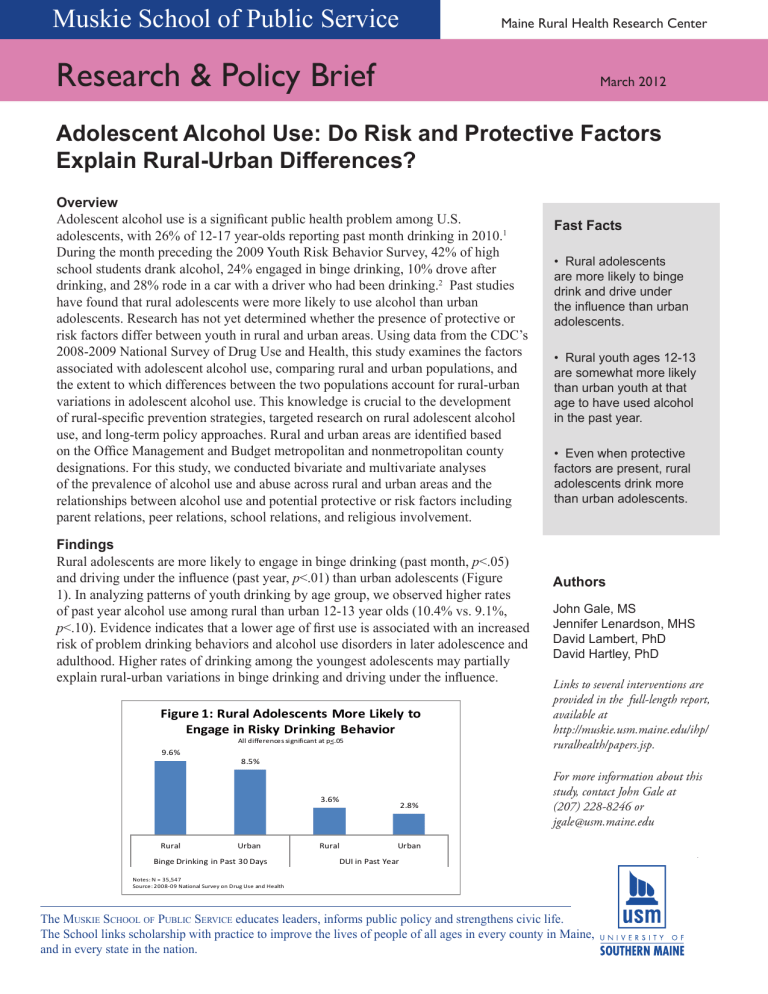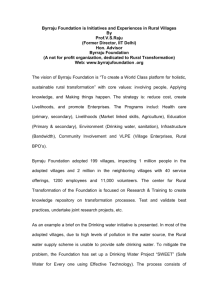Research & Policy Brief Muskie School of Public Service

Maine Rural Health Research Center
Research & Policy Brief
March 2012
Adolescent Alcohol Use: Do Risk and Protective Factors
Explain Rural-Urban Differences?
Overview
Adolescent alcohol use is a significant public health problem among U.S. adolescents, with 26% of 12-17 year-olds reporting past month drinking in 2010.
1
During the month preceding the 2009 Youth Risk Behavior Survey, 42% of high school students drank alcohol, 24% engaged in binge drinking, 10% drove after drinking, and 28% rode in a car with a driver who had been drinking.
2 Past studies have found that rural adolescents were more likely to use alcohol than urban adolescents. Research has not yet determined whether the presence of protective or risk factors differ between youth in rural and urban areas. Using data from the CDC’s
2008-2009 National Survey of Drug Use and Health, this study examines the factors associated with adolescent alcohol use, comparing rural and urban populations, and the extent to which differences between the two populations account for rural-urban variations in adolescent alcohol use. This knowledge is crucial to the development of rural-specific prevention strategies, targeted research on rural adolescent alcohol use, and long-term policy approaches. Rural and urban areas are identified based on the Office Management and Budget metropolitan and nonmetropolitan county designations. For this study, we conducted bivariate and multivariate analyses of the prevalence of alcohol use and abuse across rural and urban areas and the relationships between alcohol use and potential protective or risk factors including parent relations, peer relations, school relations, and religious involvement.
Findings
Rural adolescents are more likely to engage in binge drinking (past month, p <.05) and driving under the influence (past year, p <.01) than urban adolescents (Figure
1). In analyzing patterns of youth drinking by age group, we observed higher rates of past year alcohol use among rural than urban 12-13 year olds (10.4% vs. 9.1%, p <.10). Evidence indicates that a lower age of first use is associated with an increased risk of problem drinking behaviors and alcohol use disorders in later adolescence and adulthood. Higher rates of drinking among the youngest adolescents may partially explain rural-urban variations in binge drinking and driving under the influence.
Figure 1: Rural Adolescents More Likely to
Engage in Risky Drinking Behavior
All differences significant at p<.05
9.6%
8.5%
3.6%
2.8%
Fast Facts
• Rural adolescents are more likely to binge drink and drive under the influence than urban adolescents.
• Rural youth ages 12-13 are somewhat more likely than urban youth at that age to have used alcohol in the past year.
• Even when protective factors are present, rural adolescents drink more than urban adolescents.
Authors
John Gale, MS
Jennifer Lenardson, MHS
David Lambert, PhD
David Hartley, PhD
Links to several interventions are provided in the full-length report, available at http://muskie.usm.maine.edu/ihp/ ruralhealth/papers.jsp.
For more information about this study, contact John Gale at
(207) 228-8246 or jgale@usm.maine.edu
Rural Urban
Binge Drinking in Past 30 Days
Notes: N = 35,547
Source: 2008-09 National Survey on Drug Use and Health
Rural
DUI in Past Year
Urban
The M uskie
s chool of
P ublic
s ervice
educates leaders, informs public policy and strengthens civic life.
The School links scholarship with practice to improve the lives of people of all ages in every county in Maine, and in every state in the nation.
Adolescents are less likely to binge drink when selected protective factors (including parent disapproval of drinking, parent help with homework, youth likes school, youth disapproves of peers drinking alcohol, friends disapprove of youth drinking alcohol, and religious beliefs influence life decisions) are present (Figure 2). Many of these protective factors are less common among rural youth, e.g. parents disapprove of drinking and friends disapprove of drinking;
Figure 2: Influence of Protective
Factors on Adolescent Binge Drinking
Percents refer to those participating in binge drinking.
All differences significant at p ≤ .001
23.6%
22.3%
13.7%
6.8% 6.1% 6.1%
Yes No Yes No
Parents disapprove of youth drinking
Friends disapprove of youth drinking 1+ alcohol beverage/day
Notes: N = 3,324
Source: 2008-09 National Survey on Drug Use and Health
Yes No
Religious beliefs should influence life decisions while others are more common among rural youth, e.g. parents help with homework and religious beliefs influence life’s decisions (Figure 3). However, rural residence is associated with increased odds of binge drinking (OR 1.16, p < .05) and driving under the influence (OR 1.42, p < .001) even when these factors are taken into account (Table).
Policy Implications
Rural adolescent alcohol use is a complex social problem.
After controlling for a broad range of key risk and preventive factors, it is clear that an unexplained rural effect persists. Although we are unable to explain fully the cause of higher rural adolescent drinking, we identify rural
Figure 3: Protective Factors Vary by Residence
All differences significant at p< .001
86.6%
89.3%
82.1%
Rural Urban
84.3%
76.8%
73.8%
70.4%
64.9%
Parents disapprove of youth drinking
Friends disapprove of youth drinking 1+ alcohol beverage/day
Notes: N = 35,547
Source: 2008-09 National Survey on Drug Use and Health
Parents help with homework always/sometimes
Religious beliefs influence life decisions differences in a number of risk and protective factors that, when viewed together, may help to account for a portion of the differences in rural adolescent alcohol use and suggest opportunities for intervention. Given the multiple protective and risk factors at work in rural areas and higher rates of drinking among very young rural adolescents, our research suggests that prevention strategies should target pre-teens and younger adolescents and directly involve parents, peers, schools and churches. Our research also suggests that multiple intervention strategies with consistent messages should target different community organizations and populations.
References
1. Center for Behavioral Statistics and Quality. Results From the 2010 National
Survey on Drug Use and Health: Summary of National Findings. Washington,
D.C.: US DHHS: SAMHSA; September 2011.
2. Eaton DK et al. Youth Risk Behavior Surveillance-United States, 2009.
MMWR Morb Mortal Wkly Rep. 2010; 59(SS05): 1-142.
3. Hawkins JD et al. Exploring the Effects of Age of Alcohol Use Initiation and
Psychosocial Risk Factors on Subsequent Alcohol Misuse. J Stud Alcohol. 1997;
58(3): 280-90.
Table. Risk and Protective Factors Associated with Adolescent Alcohol Use
Control Variables
Binge Drinking in the Past 30 Days
Odds Ratios^
Rural Residence
Age (included as an ordinal variable)
Family income below 100% of FPL
Parents disapprove of youth drinking
Parents help with homework always/sometimes
Youth liked school a lot or kind of liked school
Participated in two or more youth activities
Youth disapproves of peers drinking 1+ alcohol beverage/day
Friends disapprove of youth drinking 1+ alcohol beverage/day
Attended religious services 25+ times in past year
Religious should beliefs influence life decisions
Differences significant at p ≤ .05*; p ≤ .001***.
1.16
2.88
0.77
0.47
***
0.74
0.57
*
***
***
***
***
1.10
0.45
0.60
***
0.68
0.69
***
***
***
^ Odds ratios over 1.0 are risk factors, while those less than 1.0 are protective factors.
Maine Rural Health Research Center http://muskie.usm.maine.edu/ihp/ruralhealth
Supported by the federal Office of Rural Health Policy,
Health Resources and Services Administration,
U.S. Department of Health and Human Services, CA#U1CRH03716
R
Driving Under the
Influence in the
Past Year O.R.^
1.42
5.73
0.59
0.66
0.65
0.53
1.39
***
***
***
***
***
***
0.49
**
***
0.66
**
0.93
0.58
***
H R C
Rural Health Research
& Policy Centers
Funded by the Federal Office of Rural Health Policy www.ruralhealthresearch.org





